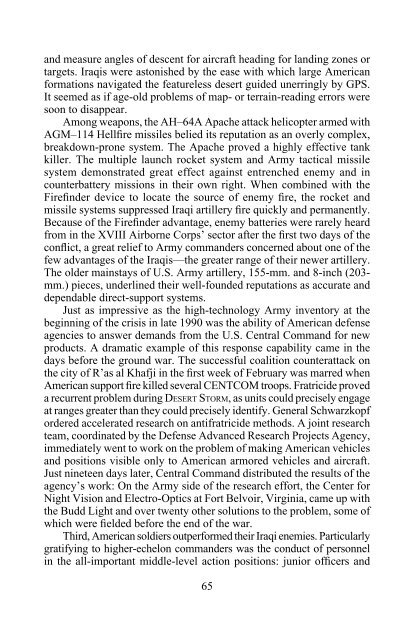Create successful ePaper yourself
Turn your PDF publications into a flip-book with our unique Google optimized e-Paper software.
and measure angles of descent for aircraft heading for landing zones ortargets. Iraqis were astonished by the ease with which large Americanformations navigated the featureless desert guided unerringly by GPS.It seemed as if age-old problems of map- or terrain-reading errors weresoon to disappear.Among weapons, the AH–64A Apache attack helicopter armed withAGM–114 Hellfire missiles belied its reputation as an overly complex,breakdown-prone system. The Apache proved a highly effective tankkiller. The multiple launch rocket system and Army tactical missilesystem demonstrated great effect against entrenched enemy and incounterbattery missions in their own right. When combined with theFirefinder device to locate the source of enemy fire, the rocket andmissile systems suppressed Iraqi artillery fire quickly and permanently.Because of the Firefinder advantage, enemy batteries were rarely heardfrom in the XVIII Airborne Corps’ sector after the first two days of theconflict, a great relief to Army commanders concerned about one of thefew advantages of the Iraqis—the greater range of their newer artillery.The older mainstays of U.S. Army artillery, 155-mm. and 8-inch (203-mm.) pieces, underlined their well-founded reputations as accurate anddependable direct-support systems.Just as impressive as the high-technology Army inventory at thebeginning of the crisis in late 1990 was the ability of American defenseagencies to answer demands from the U.S. Central Command for newproducts. A dramatic example of this response capability came in thedays before the ground war. The successful coalition counterattack onthe city of R’as al Khafji in the first week of February was marred whenAmerican support fire killed several CENTCOM troops. Fratricide proveda recurrent problem during Desert Storm, as units could precisely engageat ranges greater than they could precisely identify. General Schwarzkopfordered accelerated research on antifratricide methods. A joint researchteam, coordinated by the Defense Advanced Research Projects Agency,immediately went to work on the problem of making American vehiclesand positions visible only to American armored vehicles and aircraft.Just nineteen days later, Central Command distributed the results of theagency’s work: On the Army side of the research effort, the Center forNight Vision and Electro-Optics at Fort Belvoir, Virginia, came up withthe Budd Light and over twenty other solutions to the problem, some ofwhich were fielded before the end of the war.Third, American soldiers outperformed their Iraqi enemies. Particularlygratifying to higher-echelon commanders was the conduct of personnelin the all-important middle-level action positions: junior officers and65












